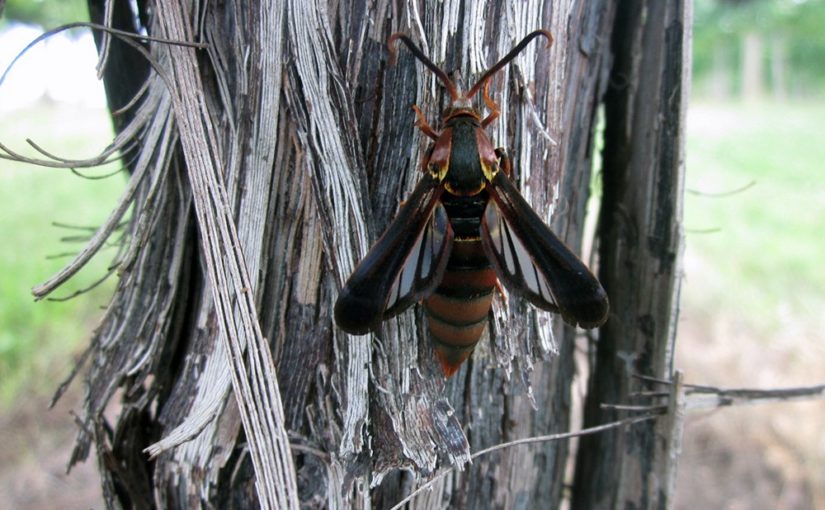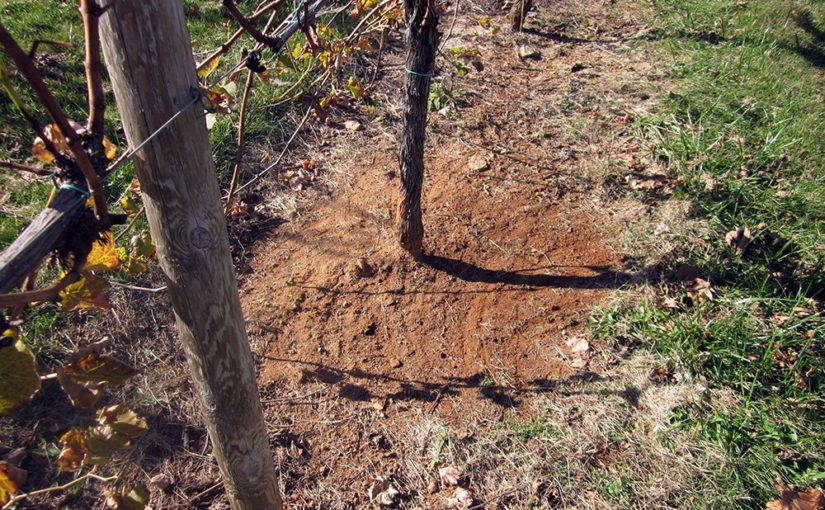Jan 3, 2018Grape root borer seen in eastern U.S. vineyards
As few as nine larvae of the grape root borer (Vitacea polistiformis) may be enough to fatally damage a grape plant with an 8-inch base circumference. They are slow killers but hard to detect.
A stealthy pest hides beneath the soil surface in many vineyards in the eastern United States. And, by the time grape growers detect the intruder, it’s usually too late – their vines may be fatally damaged.


At first glance, thegrape root borer (Vitacea polistiformis) looks like a common paper wasp, a generally beneficial insect in the vineyard. But this deceitful pest is in fact a moth whose larvae burrow underground where they bore into grapevine roots and spend a year or more feeding.
In a new guide published in the open-access of Journal of Integrated Pest Management, Jhalendra Rijal, Ph.D., area IPM advisor at the University of California Cooperative Extension, and Christopher Bergh, Ph.D., professor of tree fruit and grape entomology at Virginia Tech, review the natural history of the grape root borer as well as available monitoring and control techniques for the pest. Although borers can cause economically significant damage to vineyards, development of IPM methods to address them has been slow.
After emerging from the soil near the base of grapevines, adult female grape root borers begin “calling in” male borers by emitting pheromones. Between 350 and 500 eggs are laid singly along the grapevine, but many may fall on the ground. The eggs hatch in about two weeks and larvae fall to the ground, where they immediately burrow into the soil and begin feeding on the grapevine’s roots. When they are ready to pupate, the larvae move to just below the soil surface, where metamorphosis takes about one month. Then the pupa wriggles its way to the soil surface and the adult moth emerges.


Grape root borers are native to the eastern U.S. and have been eating cultivated wine and table grapes since at least the mid-1800s. It is thought that the pest usually spreads into vineyards from population reservoirs on native grape species. Damage from grape root borers can be devastating. Between 1967 and 1975, borers destroyed 300 to 350 acres of bunch grapes in South Carolina, causing many growers in the state to abandon the crop.
Vines under attack by borers exhibit wilting, discolored, and stunted leaves, reduced shoot growth, and produce fewer, smaller grapes. Collectively, these symptoms are referred to as “slow vine decline.” Unfortunately, grape root borers are not the only pest or pathogen that can cause this constellation of symptoms, which makes borer infestation difficult to diagnose. Vines usually don’t even show symptoms until borers have feeding on them for five to 10 years. They may be slow killers, but just nine larvae may be enough to kill a robust vine with an 8-inch base circumference.
Currently, grape growers’ options for monitoring this pest include inspecting grapevine roots, using pheromone baited traps to catch adults, and inspecting the ground surrounding vines for pupal exuviae or “shells.” Inspecting roots requires digging up vines, which is obviously destructive. Pheromone baited traps are effective, but perhaps too effective. They can attract males from long distances, perhaps even from wild grapevines or nearby vineyards, and so many not give the best estimate of borer populations in the vineyard of concern.
Rijal and Bergh say that inspecting the ground for exuviae is currently the “only unequivocal, nondestructive indicator of the infestation status of individual vines and vineyard blocks.” But Rijal cautions that this technique “requires some level of time and dedication.” To survey for exuviae, a 1-meter diameter circle must be cleared of vegetation and leaf litter around the base of the vine. Exuviae are easy to see against a background of bare soil. This “skirt” of bare soil must be maintained during the period of adult emergence, which can be eight weeks or more depending on latitude and weather.
Cultural practices, including mounding soil around the base of vines or using plastic sheeting as barrier, can reduce adult emergence and reduce infestation. But these practices can be labor and cost intensive. Unfortunately, researchers have not yet found convincing evidence of resistance to grape root borer in either native or commercially grown grape species.
Grape root borers have a variety of natural enemies when they are adults, including birds, firefly larvae, and a parasitoid. But, so far, most research into possible biological control for borers has focused on nematodes that can attack borer larvae under the soil. Two commercially available nematodes, Heterorhabditis bacteriophora, and H. megidis, have been shown to be as effective as the only available insecticide, chlorpyrifos. These are not widely used but could prove a good alternative to chemical control. Many growers are reluctant to use chlorpyrifos due to its perceived effects on soil biodiversity and wine quality.
Rijal’s previous research on grape root borer showed that infestations can be highly spatially variable. One vineyard, or one section of a vineyard, might have a severe infestation while neighboring areas do not. This variability may contribute to the lack of awareness of this pest—it is a sporadic, not area-wide, problem. In addition, the borer spends most of its lifetime, and does most of its damage, underground, making it hard to research.
“Grape root borer is considered an ‘out of sight, out of mind’ problem,” says Rijal. The insect is not attacking the visible parts of the plant (e.g., leaves and fruit) so growers are less likely to take notice. “In case of grape root borer,” says Rijal, “the infestation is not evident in early years; you don’t see any symptoms aboveground. In many cases, it is too late when growers find out.”
But, as the wine industry in the eastern U.S. grows, the economic costs of grape root borer will also increase. This pest will likely get more attention from grape growers and IPM researchers in the future.
Read more:
–Meredith Swett Walker, Journal of Integrated Pest Management
Photo above: A profile in the open-access Journal of Integrated Pest Management offers guidance on managing the pest. Photo: Christopher Bergh.















